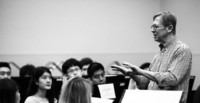This is Scott Hippensteel’s excellent dissertation from 2011 on Unending Stream of Life. He situates David’s music in wind ensemble literature, discusses his style, and expertly analyses the piece itself. His recommendations for conductors preparing the work are especially helpful.
A Study of David Maslanka’s Unending Stream of Life
PDF, 7 MB
Abstract:
This study presents an overview of the compositional style of David Maslanka and an analysis of his piece for wind band Unending Stream of Life. The seven-movement work is based in part on the melody of the hymn tune Lasst uns Erfreuen, which is commonly known as All Creatures of Our God and King. David Maslanka has developed a unique compositional style that has been strongly influenced by the chorales of J.S. Bach and the writings of Swiss psychologist Carl Jung. Through the process of “active imagining” Maslanka creates original works for wind band. The use of a hymn tune melody and short motives, both conventional and contemporary harmonic progressions, baroque and classical forms, tonal centricity, strong rhythmic drive, expanded instrumentation, and the theme of transformation are all essential to Maslanka’s compositional style. The study is intended to inform scholars and conductors about the melodic material, harmony and tonality, form, rhythm and tempo relations, orchestration, and unifying elements and musical nuances of David Maslanka’s Unending Stream of Life.



